< Previous | Contents | Next >
The Lord Treasurer
PAPPLEWICK. Here kings hunted when it was all wild forest, and every boy will tell you that here Robin Hood stabled his horses in a cave cut in the solid rock, now guarded by a gaunt old oak. The place is older still, for its name tells us that it was the home of a Saxon chieftain. Today it is delightful with pretty lanes and bright gardens, plantations, and a babbling brook.
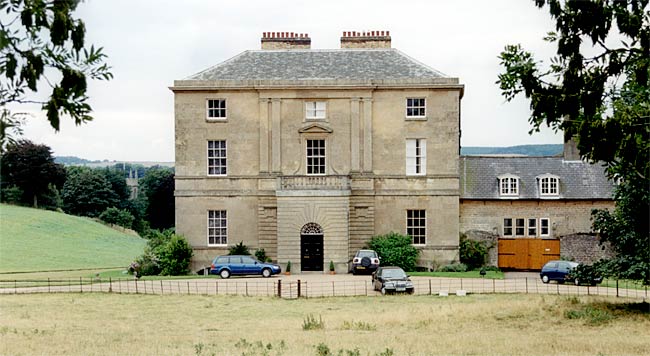
Papplewick Hall in 2003.
The great house was planned by the Adam brothers for Frederick Montagu, Lord of the Treasury, who sleeps in this country churchyard under an unusual tomb like a stone table resting on six legs. In this charming forest-like retreat is a splendid old yew 14 feet round the trunk, its branches covering a patch of ground about 60 yards round. From here we see Papplewick Dam below the church, a sheet of water reminding us of the days when the little River Leen was busy working cotton mills.
The Lord Treasurer, who sought to abolish the fast day for King Charles 90 years before it was in fact abolished, and who helped to prepare the impeachment of Warren Hastings, loved nothing better than his home in this village where he lived about 13 years, making plantations and giving them names of commanders famous in the naval victories of the time. He was a great friend of authors and poets, among them Thomas Gray and William Mason, Mason writing part of his English Garden here.
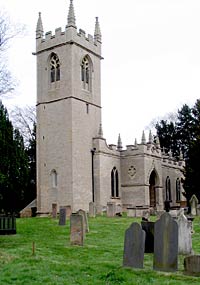
Papplewick church in 2003.
Except for its 14th century tower, Montagu rebuilt the odd little church in the style of his day, and his initials are on the porch. There is a memorial to his father, Charles Montagu, and one to Lady Culladon, wife of Queen Anne's physician, whose daughter Charles married.
Over the doorway into the church is a small figure of St James with his pilgrim's staff; he is at any rate as old as Norman. The shallow battered bowl of the font, thought by some to be Saxon, was restored to the church a few years ago from the churchyard. Other interesting relics are a number of coffin stones showing the occupations of the men they commemorate. One in the nave floor has the bow and arrow, the belt and hunting horn of the forester; and another has a cross and billhook. Two in the porch are rare for having a pair of bellows, the symbol of the ironworker. They are perhaps 700 years old, and are believed to have marked the graves of officials who had charge of the mill erected by the monks of Newstead on the outskirts of Bulwell, which was used as a forest smithy. Known as the Forge Mill, this stone mill was still grinding corn in 1938.
Fragments of 15th century glass have figures of Peter and Stephen, a knight kneeling at a desk, and a procession of monks. Lovely figures of Faith and Hope in the east window are copied from Sir Joshua Reynolds's picture in a window of New College Chapel, Oxford. The squire's pew still has its old fireplace, and the story is told how Squire Walter, a proprietor of The Times who lived at Papplewick Hall for about 30 years, used to poke the fire noisily when he had had enough of the sermon.
The Forest Oaks
PERLETHORPE. It stands on the edge of Thoresby Park, where the glorious oaks and beeches make a wonderful setting for the fine modern house of Earl Manvers.
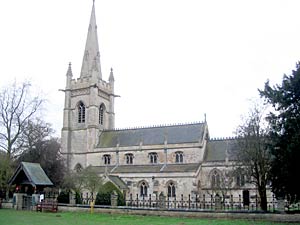
Perlethorpe church in 2007.
Just inside the park gates, a peace memorial lychgate carved with vines opens to a beautiful churchyard rich with shrubs and noble trees, two of them magnificent beeches and two splendid yews. We may wonder if any church has more natural beauty about it, and this church is worthy of it. It is not yet nearly a centenarian, having been built in 1876 by Earl Manvers. Its walls are adorned with battlements, pinnacles, and buttresses, corbel heads and gargoyles, and bands of quatrefoils; and rising to 128 feet from a lovely tower is a spire with two tiers of windows, like a needle in the sky seen from far around.
It is lovely inside and full of light, and in its enrichment the oaks of the Forest have a place, for the lovely stalls, the benches, and the pulpit have been shaped and carved from them by masters of their craft. The pulpit has a stone and marble base with handsome foliage capitals crowning the pillars. The bench-ends have exquisite carving of fruit, and medallions in which we found a bird on her nest, a pomegranate, a water-lily, and a passion flower. The stalls have a fine array of 16 crouching animals, and there is a fine door to the tower.
There is rich stone carving in the corbel heads of bearded men on the nave arcades, and in their foliage capitals; in the splendid font on pillars of coloured marble; and in the reredos, showing the Good Shepherd and the Four Evangelists. The Te Deum east window, with figures of St Martin, St John, St James, and St Margaret, is in memory of the 3rd Earl Manvers who built the church; he died in 1900. The 4th Earl has a small white monument with a figure of St George and the Dragon in a wreath of flowers, daintily carved and delicately coloured. A picture of St Peter's Denial hanging in the chancel is said to be by Benjamin West.
A rare treasure of the village is its register, for it is one of only three now known to go so far back as 1528. It is curious that one of the other two should be only three miles away at Carburton, the third being at Elsworth in Cambridgeshire.
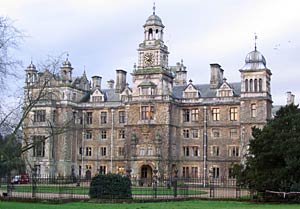
Thoresby Hall in 2007.
Thoresby House in the deer park was built last century, a quarter of a mile from the site of the house where Lady Mary Montagu was born and where she spent much of her girlhood. Formed in 1683 with 2000 acres, the park is a world of its own, over 12 miles round, with a beautiful lake of 65 acres, filled by the River Meden. It is a magnificent fragment of the old Sherwood Forest.
Marvellous Mary Montagu
LADY MARY MONTAGU, born in this great park when it was new, was a queen among the wits and poets of 18th century England. Her father was the Duke of Kingston, and being left motherless at five she grew up in her father's library, a student, beautiful, and witty.
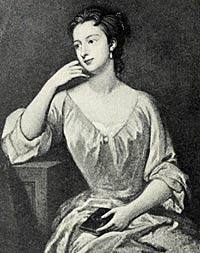
Lady Mary Wortley Montagu.
At 23 she defied her father by marrying Edward Wortley Montagu, with whom she went to Turkey, where she wrote the brilliant letters on which her fame rests. Adopting Turkish costume, she studied Turkish, and was the first to present in modern language and with modern ideas a picture of a land then veiled in mystery.
Next in importance to her letters was her introduction into England from the East of inoculation for smallpox, a fact recorded on her cenotaph in Lichfield Cathedral. For 20 years after her return to England she was a neighbour of Pope at Twickenham, but, her friendship with the poet ending in a quarrel, he savagely satirised her under the name of Sappho.
In 1739, her daughter having eloped with Lord Bute, and her millionaire husband being generally absent from her, she left England and did not return until after his death, living a strange and lonely life for 22 years in various parts of Italy. She reached England again in 1761, with spirit undimmed, but stricken with a fatal disease, and, dying a year later, was laid to rest in London.
